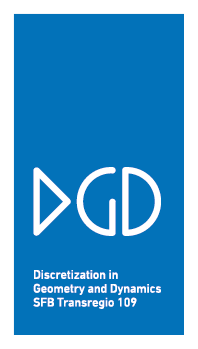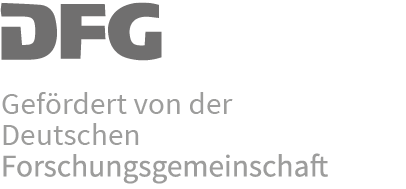Projects in Funding Period 2012 - 2016
Projects of the SFB Transregio 109 in Funding Period 2012 - 2016
A01: Discrete Riemann Surfaces (continued)
- Investigating the Facets of Discrete Complex Analysis
- Principal Investigators: Alexander Bobenko, Ulrike Bücking, Boris Springborn
- Investigators: Niklas Affolter, Nikolay Dimitrov, Felix Knöppel, Hana Kouřimská, Isabella Retter, Stefan Sechelmann, Lara Skuppin
-
Riemann surfaces arise in complex analysis as the natural domain of holomorphic functions. They are oriented two-dimensional real manifolds with a conformal structure. Several discretizations of Riemann surfaces exist, e.g., involving discretized Cauchy-Riemann equations, patterns of circles, or discrete conformal equivalence of triangle meshes. Project A01 aims at developing a comprehensive theory including discrete versions of theorems such as uniformization, convergence issues and connections to mathematical physics.
A02: Discrete Constant Mean Curvature Surfaces (continued as A02: Discrete Parametrized Surfaces)
- Developing a Theory of Discrete Surfaces with Constant Mean Curvature
- Principal Investigators: Tim Hoffmann, Alexander Bobenko
- Investigators: Benno König, Jan Techter, Zi Ye
-
In recent years, an exhaustive theory has been developed to understand and construct discrete minimal surfaces. We aim to produce something similar for the construction and classification of discrete surfaces with constant mean curvature (cmc). In particular, for discrete minimal surfaces the study of Koebe polyhedra that serve as Gauß maps has been fruitful - we are interested in analoga for discrete surfaces with constant mean curvature.
A03: Geometric Constraints for Polytopes (continued)
- Exploring the Subtle Interplay of Geometry and Combinatorics
- Principal Investigators: Günter Ziegler, Raman Sanyal, Carsten Lange
- Investigators: Philip Brinkmann, Moritz Firsching, Tobias Friedl, Lauri Loiskekoski, Hannah Schäfer Sjöberg
-
Polytopes are solid bodies bounded by flat facets. Alternatively, they can be described as the convex hull of their vertices. Thus a polytope can be presented by information on two aspects, a geometric one: "What are the coordinates of the vertices" and a combinatorial one: "Which vertex is incident to which face". There are many interrelations between these two levels: Combinatorial requirements enforce restrictions on the geometry, and vice versa. A03 studies aspects of this interplay.
A04: Integrating Discrete Geometries and Finite Element Spaces (completed)
- Building Bridges Between Discretization in Computational Geometry and in Finite Element Analysis
- Principal Investigators: Folkmar Bornemann, Konrad Polthier
- Investigators: Anna Wawrzinek
-
Finite element methods are in every day use in engineering and modelling. The main idea with finite elements is to discretize objects such as machine parts or architectural elements in order to then simulate the movement and behaviour of these objects via discrete computations. Project A04 aims to link experiences from those applications of scientific computing with ideas from discrete geometry to improve the integration of technologies.
A05: Conformal Deformations of Discrete Surfaces (continued)
- The Construction of a Discrete Differential Geometry Version of Certain Conformal Deformations
- Principal Investigators: Ulrich Pinkall
- Investigators: David Chubelaschwili, Wai Yeung Lam
-
Two geometries can be considered equivalent if there exists an angle preserving transformation between them; this is a so called conformal transformation. In the smooth case, conformal equivalences are quite well understood. However, mimicking their construction in the discrete case brought up not only interesting properties and algorithms, but also interesting problems - first and foremost the question of how to construct conformal deformations with certain prescribed properties.
A07: Discrete Morse Theory (completed)
- Finding Global Topological Information from Local Properties in a Discrete World
- Principal Investigators: Günter Rote
- Investigators: Dror Atariah, Bruno Benedetti
-
The idea behind Morse theory is to derive global topological information about objects which are locally investigated by means of differential geometry. Although originally coming from the smooth world, Morse theory has also been adapted several years ago to discrete objects, for instance to triangulations. But there are many open questions, particularly concerning those vertices in the nets that are critical for the underlying topology.
A08: Discrete Geometric Structures Motivated by Applications in Architecture (continued as C01: Discrete Geometric Structures Motivated by Applications and Architecture)
- Geometry Supporting the Realization of Freeform Architecture
- Principal Investigators: Alexander Bobenko, Helmut Pottmann
- Investigators: Thilo Rörig
-
Many of today's most striking buildings are nontraditional freeform shapes. Their fabrication is a big challenge, but also a rich source of research topics in geometry. Project A08 addresses key questions such as: "How can we most efficiently represent and explore the variety of manufacturable designs?" or "Can we do this even under structural constraints such as force equilibrium?" Answers to these questions are expected to support the development of next generation modelling tools which combine shape design with key aspects of function and fabrication.
A09: Semidiscrete Surfaces (continued as C01: Discrete Geometric Structures Motivated by Applications and Architecture)
- Geometry Between the Discrete and the Continuous
- Principal Investigators: Johannes Wallner
- Investigators: Wolfgang Carl
-
Semidiscrete surfaces are mappings of both continuous and discrete variables, representing the intermediate points in a spectrum of mappings spanned by the extremal cases of purely discrete and purely smooth surfaces. Our research in this area is motivated by applications, in particular the approximation of smooth surfaces by piecewise-developable ones. A great deal of their attraction of semidiscrete objects lies in the fact that they can lead us to a deeper understanding of both the discrete and continuous cases.
A10: Riemannian Manifold Learning via Shearlet Approximation (continued as C03: Shearlet approximation of brittle fracture evolutions)
- Analyzing Geometry by Applied Harmonic Analysis Methodologies
- Principal Investigators: Gitta Kutyniok
- Investigators: Jackie Ma, Philipp Petersen
-
Applied harmonic analysis provides powerful methodologies to approximate geometric objects, which might be given as a Riemannian manifold itself or as an approximating point cloud. The main tools are specifically designed representation systems such as shearlets. These systems are of a multiscale type, thus an approximation process provides different resolution levels. One might ask: "Which resolution level allows detection of which geometric properties, such as curvature or torsion?" Project A10 aims to analyze such relations between approximations and learning of geometrical properties.











